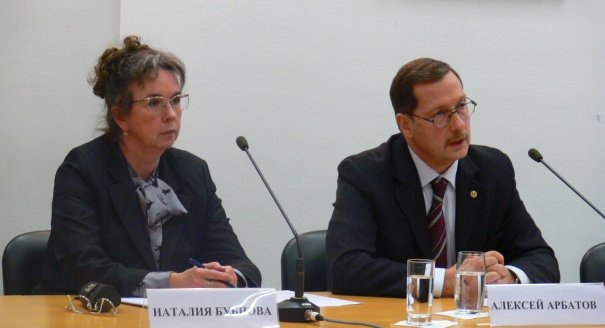Registration
You will receive an email confirming your registration.
IMGXYZ4039IMGZYXRussian-U.S.-Chinese relations in the sphere of strategic stability are becoming a popular topic of discussion among politicians, but analytical research on the topic is still in its beginning stages. These trilateral relations were discussed at an event at the Carnegie Moscow Center. Carnegie’s Alexey Arbatov spoke, and Natalia Bubnova moderated.
Military-Strategic Relations in the “Big Triangle”
Relations between the so-called “Big Triangle” of Russia, the United States, and China are a complex knot of interests and contradictions, participants agreed. This is especially true in the sphere of offensive and defensive, as well as strategic and nonstrategic, weapons.
- Russia and the United States: The relations between Russia and the United States are those of mutual nuclear deterrence based on the inability of each side to prevent the retaliatory nuclear attack of the other, participants said.
- The United States and China: Relations between the United States and China are also those of mutual nuclear deterrence which may be characterized as asymmetric and latent, added a participant.
- Russia and China: Although Russia and China are officially recognized as partners, there are some signs of partial deployment of the countries’ nuclear forces against each other, participants said.
Nuclear Weapons in Military Policies
Nuclear weapons play different roles in the military policies of Russia, the United States, and China, participants said. This divergence hinders the creation of a common foundation for the triangle strategic relations. Participants discussed the role nuclear weapons play in each country’s military policy:
- Russia: Nuclear weapons play the greatest role in Russia’s military policy, since the country perceives itself as weak in the sphere of conventional weapons.
- The United States: The Unites States also considers their nuclear weapons as very important, despite the growing role of missile defense systems and high-precision weapons in U.S. military policy.
- China: China relies on nuclear weapons less than Russia and the United States do. Beijing also acknowledges that it lags behind the other two countries in this sphere.
Nuclear Doctrines of Russia and the United States
There are only two significant differences between the Russian and American nuclear doctrines, participants asserted.
- The United States openly shifts its focus to defensive and high-precision weapons, while Russia remains invested in the concept of nuclear deterrence. Nevertheless, Russia is also developing air and space defenses and high-precision weapons.
- The United States reserves the right of the first nuclear strike for its allies’ defense, while Russia does not commit itself to using nuclear weapons in the defense of its allies.
Contradictions in China’s Nuclear Doctrine
A number of points in the Chinese doctrine create serious questions among the researchers, participants said.
- Forfeiting First Nuclear Strike: China’s unconditional commitment of non-first-use, which differentiates it from other nuclear states, implies that China believes itself capable of a retaliatory strike. Otherwise, the Chinese commitment raises serious doubts.
- Minimal Nuclear Deterrence: China limits itself to declarations of minimal nuclear deterrence to ensure its national security. These declarations do not allow for an objective assessment of China’s current nuclear capability and its prospects.
- Lack of Transparency: China is the only state that does not divulge any information on its nuclear potential, participants added. Both Russia (as well as USSR earlier) and the United States allowed and still allow for certain transparency in the sphere of nuclear weapons.
Chinese Involvement in the Arms Control Process
- The Impossibility of the Trilateral Format: The transition from a bilateral arms control between Russia and the United States to a trilateral one that includes China is impossible in the foreseeable future, participants argued. However, there is a theoretical possibility of parallel negotiations between the United States and Russia and the United States and China which would include simultaneous consultations between Russia and China. In such talks, China is seen as the “toughest” of the three participants, participants acknowledged.
- Possible Concessions to China: Russia and the United States will have to offer something to China to encourage it to take part in the negotiations, participants said. They suggested that the following concessions might be made:
- On Behalf of the United States: The United States’ commitment to refrain from enhancing its missile defenses in the Asia-Pacific region could serve as a valuable concession.
- On Behalf of Russia: Russia could commit to keeping its tactical nuclear weapons inside its European land and agree not to relocate them to its Eastern lands.
- On Behalf of the United States: The United States’ commitment to refrain from enhancing its missile defenses in the Asia-Pacific region could serve as a valuable concession.
- What Russia and the United States Expect of China: The immediate goal of involving China in negotiations on nuclear arms is intended to ensure at least relative transparency in Beijing’s nuclear arsenal, explained the participants. This information has bearing on the Russian-American disarmament prospects: if China has 200 to 300 nuclear warheads, Russia and the United States may further reduce their nuclear arsenals without compromising their national security. However, further arms reductions may prove problematic if China has 800 to 900, or more, warheads, participants concluded.
